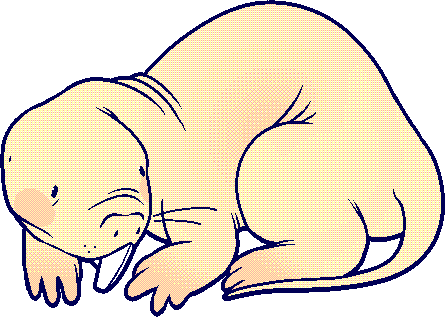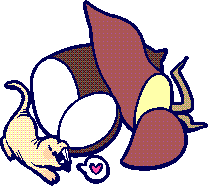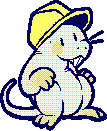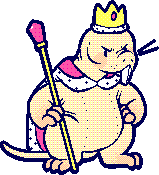


NAKED MOLE-RAT
The naked mole-rat (Heterocephalus glaber) is an unusual rodent native to East Africa. Though known for their "ugly" appearance, they are extremely unique mammals with highly complex social structures. They and one other species of mole-rat are the only known eusocial mammals! They also have the longest lifespans of any rodent, and a resistance to cancer and other diseases. They are also known as sand puppies!

- Class Mammalia
- Diet Herbivore
- Length 8-10cm (3-4in)
- Weight 30-50g (1-1.8oz)
- Status Least concern
- Environment Tropical grasslands, deserts
- Health 125/150
- Attack 75/150
- Defense 25/150
- Speed 5/150
- Abilities Pain resistance, cancer resistance, low oxygen requirement
- Weaknesses Snakes, birds of prey


Naked mole-rats (also known as sand puppies) are small rodents native to the arid sections of tropical grasslands and deserts of East Africa. They're most numerous in the Somali Peninsula, as well as some parts of Kenya. Naked mole-rats live underground, in giant complex tunnel systems in colonies that can range from 20 to 300 individuals! They are incredibly unique animals, one of only two species of eusocial mammals. (The other being the Damara mole-rat, a close relative with less streamlined eusocial behaviour) Their teeth are over their lips, which helps them to dig through soil without getting a mouthful of dirt every time.
 Naked mole-rats eat tubers and roots, which they find through tunnelling underground. They don't need water, since their diet covers their hydration needs! They will also consume their feces, which helps them to fully digest their food. (gross, I know) Pups are fed on a diet of the queen's milk and fecal pap, a mixture of feces and important gut bacteria. Koalas are known for doing this too! Like ants and bees, naked mole-rats do not sleep for long periods. They work all day and night and tend to sleep only in short bursts. Talk about low maintenance...
Naked mole-rats eat tubers and roots, which they find through tunnelling underground. They don't need water, since their diet covers their hydration needs! They will also consume their feces, which helps them to fully digest their food. (gross, I know) Pups are fed on a diet of the queen's milk and fecal pap, a mixture of feces and important gut bacteria. Koalas are known for doing this too! Like ants and bees, naked mole-rats do not sleep for long periods. They work all day and night and tend to sleep only in short bursts. Talk about low maintenance...
They are one of the only eusocial mammals! Eusociality is the most complex form of social organization in animals. It involves having distinct breeding and non-breeding social castes. Eusocial animals work together in large groups to serve the breeding caste. Wasps, ants, bees, and termites are all eusocial! Naked mole rat castes include workers, soldiers, breeding males, and the queen or breeding female. Dispersers are sometimes included as a social caste as well, though they are less cooperative with their mother colony. 
- Workers are the smallest and are typically infertile. They work at gathering food, excavating and maintaining burrows, and caring for the queen and her pups. The largest workers tend to overlap with
 soldiers. Workers sometimes prefer to specialize in specific areas, like some preferring to forage, some mainly tunnelling, some caring for pups, etc. etc.
soldiers. Workers sometimes prefer to specialize in specific areas, like some preferring to forage, some mainly tunnelling, some caring for pups, etc. etc. - Soldiers are the largest of the workers and tend to be more aggressive, and will defend the colony against external threats like predators.
- Breeding males are typically the best of the workers and soldiers, who the queen chooses to mate with to create more colony members. Typically only the best breeding male is chosen to be mated with, so competition is often steep.
 The queen is the breeding female and the largest of the colony. She is the mother of the majority of the colony members and spends her time being taken care of and having pups. The queen has more space between the vertebrae in her spine to fit more pups, a change that occurs by a hormonal shift upon taking the throne. She is often aggressive toward other female mole-rats, who may compete with her to take over the role. Since being a queen is not determined by genetics, any female mole-rat can technically take over the role, though only those most fit for it tend to.
The queen is the breeding female and the largest of the colony. She is the mother of the majority of the colony members and spends her time being taken care of and having pups. The queen has more space between the vertebrae in her spine to fit more pups, a change that occurs by a hormonal shift upon taking the throne. She is often aggressive toward other female mole-rats, who may compete with her to take over the role. Since being a queen is not determined by genetics, any female mole-rat can technically take over the role, though only those most fit for it tend to. Dispersers are naked mole rats with more fat reserves, who have hormones that cause them to avoid working for their colony and leave the nest to seek other colonies. This, paired with the queen mole-rat's habits of choosing non-familiar males to mate with, helps avoid inbreeding that lowers the long-term health of the colony.
Dispersers are naked mole rats with more fat reserves, who have hormones that cause them to avoid working for their colony and leave the nest to seek other colonies. This, paired with the queen mole-rat's habits of choosing non-familiar males to mate with, helps avoid inbreeding that lowers the long-term health of the colony.
Aside from eusociality, naked mole rats are also studied for their remarkable hardiness. They are the longest-living rodents, living up to 30 years. They are very cancer resistant, with only two tumours ever being found in two individuals, who lived in captivity with higher-than-usual oxygen levels. This is partially due to ribosomes which make extremely few errors when creating new proteins for cells, as well as increased DNA repair, leading to lower DNA damage and decay. They can survive in environments with extremely low oxygen and can survive with very little food. They automatically lower their metabolism, heart rate, and movement when oxygen and food are low. Their body temperatures change with their environment, making them practically cold-blooded, or ectothermic. When cold, they huddle with one another to keep each other warm.
In addition to ALL of that, they are impervious to some forms of pain! When exposed to capsaicin (the chemical that makes peppers spicy) or acid, they do not feel any pain. As adults, they have 2/3 the pain sensors of any other mammal. This is proposed to be an adaptation to high levels of carbon dioxide in their environment. Large amounts of carbon dioxide can cause blood and other bodily tissues to acidify. By not having the pain receptors for this acidification, mole-rats can work more efficiently underground.
- Sources and Attributions
- - IMAGE: Chomez, Public domain, via Wikimedia Commons
- - Wikipedia contributors. "Naked mole-rat." Wikipedia, The Free Encyclopedia. Wikipedia, The Free Encyclopedia, 4 Mar. 2024. Web. 30 Mar. 2024.
- - Smith, Ewan St John et al. “Independent evolution of pain insensitivity in African mole-rats: origins and mechanisms.” Journal of comparative physiology. A, Neuroethology, sensory, neural, and behavioral physiology vol. 206,3 (2020): 313-325. doi:10.1007/s00359-020-01414-w
- - “Naked Mole-Rat.” San Diego Zoo Wildlife Alliance Animals and Plants, animals.sandiegozoo.org/animals/naked-mole-rat. Accessed 29 Mar. 2024.
- - “Secrets of Naked Mole-Rat Cancer Resistance Unearthed.” University of Cambridge, 1 July 2020, www.cam.ac.uk/research/news/secrets-of-naked-mole-rat-cancer-resistance-unearthed.
- - “Naked Mole-Rat.” Smithsonian’s National Zoo and Conservation Biology Institute, nationalzoo.si.edu/animals/naked-mole-rat. Accessed 29 Mar. 2024.
- - My awesome fucking brain

